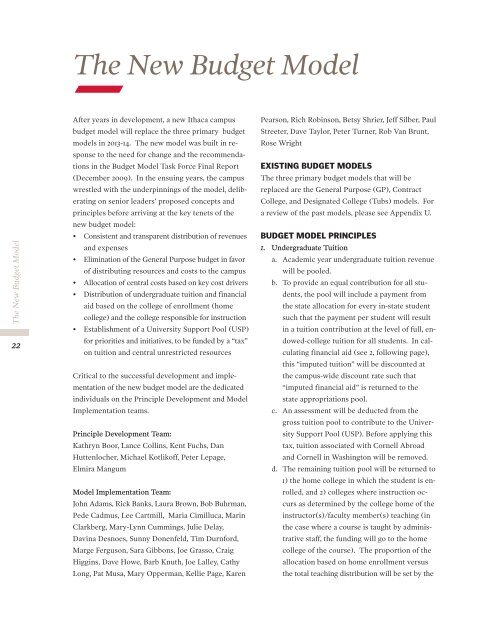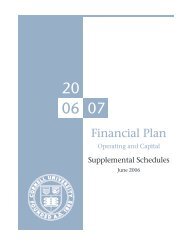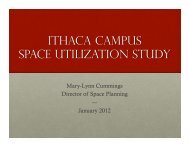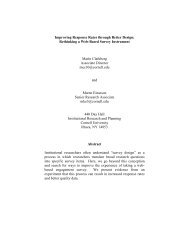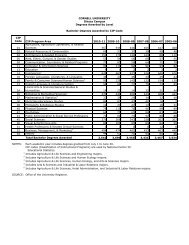2013-14 Operating & Capital Budget Plan - Cornell University ...
2013-14 Operating & Capital Budget Plan - Cornell University ...
2013-14 Operating & Capital Budget Plan - Cornell University ...
You also want an ePaper? Increase the reach of your titles
YUMPU automatically turns print PDFs into web optimized ePapers that Google loves.
The New <strong>Budget</strong> ModelThe New <strong>Budget</strong> Model22After years in development, a new Ithaca campusbudget model will replace the three primary budgetmodels in <strong>2013</strong>-<strong>14</strong>. The new model was built in responseto the need for change and the recommendationsin the <strong>Budget</strong> Model Task Force Final Report(December 2009). In the ensuing years, the campuswrestled with the underpinnings of the model, deliberatingon senior leaders’ proposed concepts andprinciples before arriving at the key tenets of thenew budget model:• Consistent and transparent distribution of revenuesand expenses• Elimination of the General Purpose budget in favorof distributing resources and costs to the campus• Allocation of central costs based on key cost drivers• Distribution of undergraduate tuition and financialaid based on the college of enrollment (homecollege) and the college responsible for instruction• Establishment of a <strong>University</strong> Support Pool (USP)for priorities and initiatives, to be funded by a “tax”on tuition and central unrestricted resourcesCritical to the successful development and implementationof the new budget model are the dedicatedindividuals on the Principle Development and ModelImplementation teams.Principle Development Team:Kathryn Boor, Lance Collins, Kent Fuchs, DanHuttenlocher, Michael Kotlikoff, Peter Lepage,Elmira MangumModel Implementation Team:John Adams, Rick Banks, Laura Brown, Bob Buhrman,Pede Cadmus, Lee Cartmill, Maria Cimilluca, MarinClarkberg, Mary-Lynn Cummings, Julie Delay,Davina Desnoes, Sunny Donenfeld, Tim Durnford,Marge Ferguson, Sara Gibbons, Joe Grasso, CraigHiggins, Dave Howe, Barb Knuth, Joe Lalley, CathyLong, Pat Musa, Mary Opperman, Kellie Page, KarenPearson, Rich Robinson, Betsy Shrier, Jeff Silber, PaulStreeter, Dave Taylor, Peter Turner, Rob Van Brunt,Rose WrightEXISTING BUDGET MODELSThe three primary budget models that will bereplaced are the General Purpose (GP), ContractCollege, and Designated College (Tubs) models. Fora review of the past models, please see Appendix U.BUDGET MODEL PRINCIPLES1. Undergraduate Tuitiona. Academic year undergraduate tuition revenuewill be pooled.b. To provide an equal contribution for all students,the pool will include a payment fromthe state allocation for every in-state studentsuch that the payment per student will resultin a tuition contribution at the level of full, endowed-collegetuition for all students. In calculatingfinancial aid (see 2, following page),this “imputed tuition” will be discounted atthe campus-wide discount rate such that“imputed financial aid” is returned to thestate appropriations pool.c. An assessment will be deducted from thegross tuition pool to contribute to the <strong>University</strong>Support Pool (USP). Before applying thistax, tuition associated with <strong>Cornell</strong> Abroadand <strong>Cornell</strong> in Washington will be removed.d. The remaining tuition pool will be returned to1) the home college in which the student is enrolled,and 2) colleges where instruction occursas determined by the college home of theinstructor(s)/faculty member(s) teaching (inthe case where a course is taught by administrativestaff, the funding will go to the homecollege of the course). The proportion of theallocation based on home enrollment versusthe total teaching distribution will be set by the


